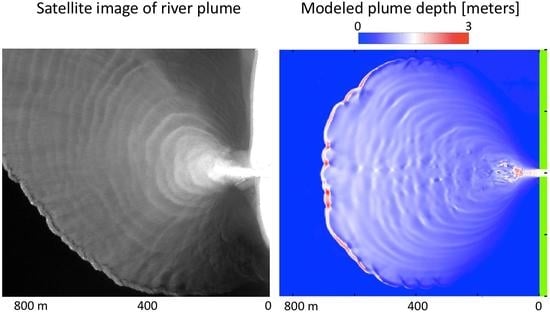Interpreting Patterns of Concentric Rings within Small Buoyant River Plumes
Abstract
:1. Introduction
2. Materials and Methods
2.1. Background
2.2. Model
3. Results
3.1. Spatial Structure
3.2. Evolving Nature of the Plume
3.3. Sensitivity to Inflow Speed and Geometry
4. Conclusions
Supplementary Materials
Author Contributions
Funding
Institutional Review Board Statement
Informed Consent Statement
Data Availability Statement
Acknowledgments
Conflicts of Interest
References
- Horner-Devine, A.R.; Hetland, R.D.; MacDonald, D.G. Mixing and transport in coastal river plumes. Ann. Rev. Fluid Mech. 2015, 47, 569–594. [Google Scholar] [CrossRef]
- Yuan, Y.; Horner-Devine, A.R. Experimental investigation of large-scale vortices in a freely spreading gravity current. Phys. Fluids 2017, 29, 106603. [Google Scholar] [CrossRef]
- Garvine, R.W. Radial spreading of buoyant, surface plumes in coastal waters. J. Geophys. Res. Oceans. 1984, 89, 1989–1996. [Google Scholar] [CrossRef]
- Osadchiev, A.A. Small mountainous rivers generate high-frequency internal waves in coastal ocean. Sci. Rep. 2018, 8, 16609. [Google Scholar] [CrossRef] [PubMed]
- Osadchiev, A.A.; Zavialov, P.O. Structure and Dynamics of Plumes Generated by Small Rivers. In Estuaries and Coastal Zones—Dynamics and Response to Environmental Changes; Pan, J., Ed.; IntechOpen: London, UK, 2019. [Google Scholar]
- Marmorino, G.; Savelyev, I.; Smith, G.B. Surface thermal structure in a shallow-water, vertical discharge from a coastal power plant. Env. Fluid Mech. 2015, 15, 207–229. [Google Scholar] [CrossRef]
- Marchevsky, I.K.; Osadchiev, A.A.; Popov, A.Y. Numerical Modelling of High-frequency Internal Waves Generated by River Discharge in Coastal Ocean. In GISTAM; 2019; pp. 384–387. Available online: https://www.scitepress.org/Papers/2019/78402/78402.pdf (accessed on 1 December 2020).
- Osadchiev, A.; Barymova, A.; Sedakov, R.; Zhiba, R.; Dbar, R. Spatial Structure, Short-temporal Variability, and Dynamical Features of Small River Plumes as Observed by Aerial Drones: Case Study of the Kodor and Bzyp River Plumes. Remote Sens. 2020, 12, 3079. [Google Scholar] [CrossRef]
- Kilcher, L.F.; Nash, J.D. Structure and dynamics of the Columbia River tidal plume front. J. Geophys. Res. 2010, 115, C05S90. [Google Scholar] [CrossRef] [Green Version]
- Wang, C.; Wang, X.; Da Silva, J.C. Studies of internal waves in the strait of Georgia based on remote sensing images. Remote Sens. 2019, 11, 96. [Google Scholar] [CrossRef] [Green Version]
- Mendes, R.; da Silva, J.C.B.; Magalhaes, J.M.; St-Denis, B.; Bourgault, D.; Pinto, J.; Dias, J.M. On the generation of internal waves by river plumes in subcritical initial conditions. Sci. Rep. 2021, 11, 1–12. [Google Scholar] [CrossRef] [PubMed]
- Osadchiev, A.A.; Sedakov, R.O. Spreading dynamics of small river plumes on the northeastern coast of the Black Sea observed by Landsat 8 and Sentinel-2. Remote Sens. Environ. 2019, 221, 522–533. [Google Scholar] [CrossRef]
- Horner-Devine, A.R.; Chickadel, C.C. Lobe-cleft instability in the buoyant gravity current generated by estuarine outflow. Geophys. Res. Lett. 2017, 44, 5001–5007. [Google Scholar] [CrossRef]
- Horner-Devine, A.; Chickadel, C.C.; MacDonald, D. Coherent Structures and Mixing at a River Plume Front. In Coherent Flow Structures in Geophysical Flows at the Earth’s Surface; Venditti, J., Best, J.L., Church, M., Hardy, R.J., Eds.; Wiley: Chichester, UK, 2013; pp. 359–369. [Google Scholar]
- Marmorino, G.O.; Trump, C.L. Gravity current structure of the Chesapeake Bay outflow plume. J. Geophys. Res. 2000, 105, 28847–28861. [Google Scholar] [CrossRef]
- Delandmeter, P.; Lambrechts, J.; Marmorino, G.O.; Legat, V.; Wolanski, E.; Remacle, J.F.; Chen, W.; Deleersnijder, E. Submesoscale tidal eddies in the wake of coral islands and reefs: Satellite data and numerical modelling. Ocean Dyn. 2017, 67, 897–913. [Google Scholar] [CrossRef]
- Osadchiev, A.A.; Zavialov, P.O. Lagrangian model of a surface-advected river plume. Cont. Shelf Res. 2013, 58, 96–106. [Google Scholar] [CrossRef]
- OpenFOAM and The OpenFOAM Foundation. Available online: https://openfoam.org/ (accessed on 10 December 2020).
- Osadchiev, A. A method for quantifying freshwater discharge rates from satellite observations and Lagrangian numerical modeling of river plumes. Environ. Res. Lett. 2015, 10, 085009. [Google Scholar] [CrossRef] [Green Version]
- Osadchiev, A.; Korshenko, E. Small river plumes off the northeastern coast of the Black Sea under average climatic and flooding discharge conditions. Ocean Sci. 2017, 13, 465–482. [Google Scholar] [CrossRef] [Green Version]
- Savelyev, I.; Miller, W.D.; Sletten, M.; Smith, G.B.; Savidge, D.K.; Frick, G.; Menk, S.; Moore, T.; De Paolo, T.; Terrill, E.J.; et al. Airborne remote sensing of the upper ocean turbulence during CASPER-East. Remote Sens. 2018, 10, 1224. [Google Scholar] [CrossRef] [Green Version]
- Trump, C.L.; Allan, N.; Marmorino, G.O. Side-looking ADCP and Doppler radar measurements across a coastal front. IEEE J. Ocean Eng. 2000, 25, 423–429. [Google Scholar] [CrossRef]
- Marmorino, G.O.; Trump, C.L. Shore-based acoustic Doppler measurement of near-surface currents across a small embayment. J. Coast. Res. 2000, 16, 864–869. [Google Scholar]








Publisher’s Note: MDPI stays neutral with regard to jurisdictional claims in published maps and institutional affiliations. |
© 2021 by the authors. Licensee MDPI, Basel, Switzerland. This article is an open access article distributed under the terms and conditions of the Creative Commons Attribution (CC BY) license (https://creativecommons.org/licenses/by/4.0/).
Share and Cite
Marmorino, G.; Evans, T. Interpreting Patterns of Concentric Rings within Small Buoyant River Plumes. Remote Sens. 2021, 13, 1361. https://0-doi-org.brum.beds.ac.uk/10.3390/rs13071361
Marmorino G, Evans T. Interpreting Patterns of Concentric Rings within Small Buoyant River Plumes. Remote Sensing. 2021; 13(7):1361. https://0-doi-org.brum.beds.ac.uk/10.3390/rs13071361
Chicago/Turabian StyleMarmorino, George, and Thomas Evans. 2021. "Interpreting Patterns of Concentric Rings within Small Buoyant River Plumes" Remote Sensing 13, no. 7: 1361. https://0-doi-org.brum.beds.ac.uk/10.3390/rs13071361





